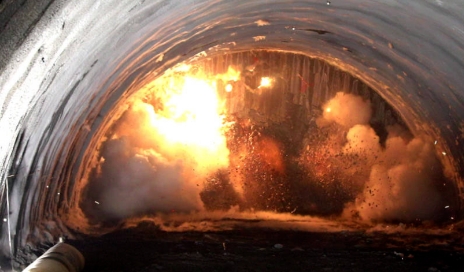Introduction and comparison of several methods of rock blasting excavation
New technology: O2 rock demolition system
Link:
Related Products:CO2 rock blasting system
Rock excavation generally adopts blasting method. According to the state of the chamber, it is divided into drilling blasting and cavern blasting. For example, in water conservancy and hydropower projects, according to the different blasting objects, blasting is usually divided into open-cut blasting, underground cavern blasting, underwater blasting, rock plug blasting, directional blasting dam construction, cofferdam blasting, etc.
Drilling blasting is divided into shallow hole blasting and deep hole blasting according to the size of the hole and the depth of the borehole. Drilling blasting with a hole diameter less than 75mm and a depth less than 5m is called shallow hole blasting. The shallow hole blasting method can evenly crush the medium, does not require complex drilling equipment, is simple to operate, can adapt to various terrain conditions, and is easy to control the shape and specifications of the excavation surface. It is mainly used in underground engineering excavation, small and medium-sized material field mining, and layered excavation of hydraulic structure foundations. However, the shallow hole blasting method has a large drilling workload, and the volume of each blast-hole is not large, so the productivity is low. Drilling blasting with a hole diameter greater than 75mm and a hole depth greater than 5m is called deep hole blasting. After the blast, a certain amount of large rocks are produced, which usually require secondary blasting. The deep hole blasting method is generally suitable for rocks of grades VVII to XIV. The deep hole blasting method is the main method for large foundation pit excavation and large quarry mining. Compared with shallow hole blasting, the drilling workload per unit volume of rock is smaller, the unit drug consumption is low, the labor productivity is "high, and the detonation operation process and labor organization can be simplified. The disadvantage is that the drilling equipment is complex and the equipment cost is high. The main parameters of deep hole blasting are: step height H, borehole diameter d, chassis resistance line Wd, blast-hole spacing a and row spacing b, over drilling depth △H, borehole depth L, plugging length L1 and single hole charge Q, etc.
Drilling blasting needs to form a step shape to reasonably arrange the blast-holes and make full use of the natural air surface or creation Create more open surfaces. The blast-holes should be perpendicular to the rock layer or joint surface, and should not pass through cracks that penetrate the ground.
1. Pre-splitting blasting is to drill a row of pre-splitting blast-holes along the designed excavation contour line, and blast before the main excavation part is blasted, so as to obtain a crack that penetrates along the designed excavation contour line, and then blast the main excavation part under the shield of the crack to prevent or weaken the propagation of blasting vibration to the rock mass outside the excavation contour. The angle of the pre-splitting blast-hole should be consistent with the slope of the excavation contour, and it is advisable to drill to the designed depth at one time.
2. Smooth blasting is to drill a row of smooth blasting holes along the designed excavation contour line, and then blast the main excavation area. Then blast the smooth blasting holes on the designed excavation contour line to remove the "smooth blasting layer" as the surrounding rock protection layer, so as to obtain a flat excavation wall. For dam foundation and slope excavation, the excavation effect of pre-splitting blasting and smooth blasting is similar. Smooth blasting is more often chosen for underground cavern excavation. For underground caverns in high ground stress areas and rock mass excavation under strong constraint conditions, smooth blasting has a better effect.
3.
Cavern blasting, also known as large blasting, refers to charging and blasting in a specially designed excavation cavern. The caverns are connected by flat tunnels or shafts, and the flat tunnels or shafts are blocked after charging. Cavern blasting has a large blasting volume at one time and high blasting efficiency. It is suitable for projects with large and concentrated excavation volume and tight time requirements; it is used for directional blasting dam construction (directional blasting interception) and mining of the secondary stockpile area of the face rockfill dam. It can be further divided into loosening blasting, throwing blasting and directional blasting.





